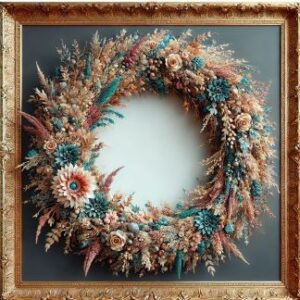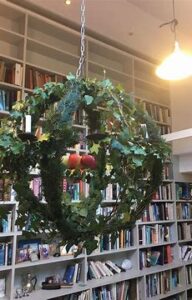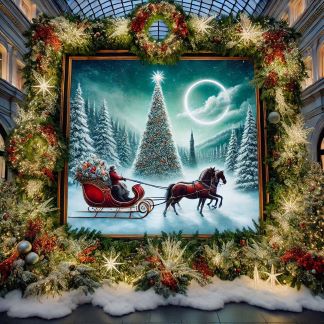The Christmas Greenery Story
From the majestic Christmas tree to the humble sprig of mistletoe,
evergreens have played a significant role in Christmas celebrations for centuries.
Christmas traditions are deeply ingrained in our culture,
and decorating our homes with greenery is an integral part of the festive season.
From the majestic Christmas tree to the humble sprig of mistletoe, evergreens have played a significant role in Christmas celebrations for centuries.
In this article, we will delve into the history of Christmas greenery, exploring the origins and evolution of these beloved traditions.
The Christmas Greenery Story
Evergreens: A Symbol of Eternal Life

Throughout history, evergreens have been a staple of Christmas decorations.
By the late Middle Ages, church records show that holly and ivy were purchased for winter decorations.
For Christians, evergreens symbolized eternal life and the promise of the return of life in the spring.
In 16th-century London, historian John Stow discovered an account from 1444,
that described how Londoners decorated their homes with “holme, ivie, bayes, and whatever the season of the year afforded to be green.”
The tradition of using evergreens in Christmas decorations continued through the centuries,
with holly and fir garlands being strewn on mantelpieces during the Victorian era.
The Christmas Greenery Story
Wreaths: A Symbol of Welcome and Celebration

Wreaths have a long history dating back to ancient Rome, where they were used as rewards for military success and excellence.
The tradition of making wreaths was also adopted by early Christians, who used them to symbolize eternal life and the circle of life.
Also, The modern Advent wreath, made of evergreen branches and candles, is believed to have originated in 16th-century Germany.
The first recorded use of an Advent wreath was in 1833 by a Lutheran clergyman, who lit a candle in a wreath every Sunday and told the nativity story.
During the 19th century, wreaths became a popular Christmas decoration in England, often made with holly, ivy, pine cones, and ribbons.
These wreaths, also known as “welcome rings,” were hung on front doors to welcome guests into the home.
The Christmas Greenery Story
Kissing Boughs: A Symbol of Goodwill and Romance

Kissing boughs, also known as “kissing hoops,” are a Christmas decoration consisting of two or four crossed hoops forming a spherical shape.
They were traditionally decorated with greenery, fruits, and ribbons.
The origins of kissing boughs are uncertain, but they are believed to have been popular in England during the Tudor period.
In the Georgian period,
kissing boughs became more elaborate, featuring greenery decorated with apples, oranges, and brightly colored ornaments.
According to tradition, gentlemen could pluck a berry from the bough and kiss a lady on the cheek.
When there were no more berries, no more kisses could be given.
This tradition may have inspired the modern practice of kissing under the mistletoe.
The Christmas Greenery Story
Mistletoe: A Symbol of Love and Friendship

Mistletoe has a long history of being associated with Christmas celebrations.
The Roman author Pliny the Elder described how Druids in Gaul ceremonially harvested mistletoe when they found it growing on oak trees, which they revered.
In England, the tradition of kissing under the mistletoe is believed to have originated in the 18th century.
The poet Robert Herrick is the first known source to associate mistletoe with Christmas in his poem “Ceremonie upon Candlemas Eve.”
The Christmas Greenery Story
Christmas Trees: A Symbol of Joy and Celebration

The modern Christmas tree tradition is often attributed to Prince Albert, Queen Victoria’s consort, who introduced the custom to England in 1840.
However, it was actually Queen Charlotte, the German wife of George III, who set up the first known Christmas tree at Queen’s Lodge, Windsor, in December 1800.
Christmas trees became popular with the upper classes, especially for children’s gatherings.
The Illustrated London News and other periodicals helped popularize the custom, depicting and describing the royal Christmas trees every year.
By 1860, Christmas trees were a staple of middle-class homes, decorated with candles, sweets, fruits, and homemade decorations.
The first artificial Christmas tree was made by Addis Housewares Company in 1930,
marking the beginning of a new era in Christmas tree traditions.
In conclusion, the history of Christmas greenery is a rich and complex one, spanning centuries and cultures.
As we decorate our homes with greenery this Christmas season, let us remember the history and symbolism behind these beloved traditions.
Whether it’s a majestic Christmas tree, a fragrant wreath,
or a sprig of mistletoe, each element of Christmas greenery adds to the magic and wonder of the festive season.
Also Read: All is Calm: Receiving Jesus Rest This Christmas – Diademng
The Christmas Greenery Story

Kissing Boughs: A Symbol of Goodwill and Romance
Kissing boughs, also known as “kissing hoops,” are a Christmas decoration consisting of two or four crossed hoops forming a spherical shape.

















NY weekly Awesome! Its genuinely remarkable post, I have got much clear idea regarding from this post . NY weekly